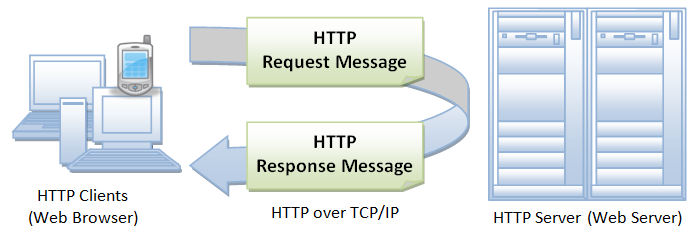

Internet
The Internet is a global system of interconnected computer networks that use the standard Internet protocol suite (TCP/IP) to link several billion devices worldwide.
TCP/IP (Transmission Control Protocol/Internet Protocol)
For end-to-end message transmission across the Internet, TCP/IP is used. It is written as TCP/IP because it is composed of two layers, the IP layer which utilizes the IP address to send/receive packets of data, and the TCP layer which makes a connection between client and server, and ensures delivery of all message packets between them.
World Wide Web (WWW)
The World Wide Web is a system of interlinked documents that are accessed via the Internet. With a web browser, one can view web pages that may contain text, images, videos, and other multimedia and navigate between them via links.
HTTP (Hypertext Transfer Protocol)
The HTTP protocol is the protocol of the World Wide Web (WWW). Like any Internet service, the web utilizes the Internet.
Web Browser
The reason for workstation/browser side programming is efficiency (speed). The server could be handling thousands of requests, and any requests from workstations have latency because of the Internet transmission time. It is much more efficient to perform any functions that you can do on the workstation, before sending the request to the server. A typical use of workstation processing is form error checking that can be done with no knowledge of server-side data, for example, blank fields, incorrect formats (dates, social security or customer numbers, etc.). The most popular scripting side language is JavaScript.
Web Server
The web server stores, processes and delivers web pages to web browsers. Web servers also Many generic web servers also support server-side programming (scripting)using Active Server Pages (ASP), PHP, Ruby, or other languages. Usually, this function is used to create HTML documents dynamically ("on-the-fly") as opposed to returning static documents.
Techniques called template methods are now popular for server-side programming. The HTML page to send to the browser is in a file. Where processing has to be done (to fill in a table with data for example, or modify the web page), a call is made to a language interpreter to do it. The language may be a specialized language used just for web programming (PHP for example), or a general purpose language (Ruby on Rails, or a Microsoft language (Visual Basic) using ASP.Net). The template methods are popular because they allow for a “division of labor”. The web design (the HTML page) can be done by one group, the programming by another.